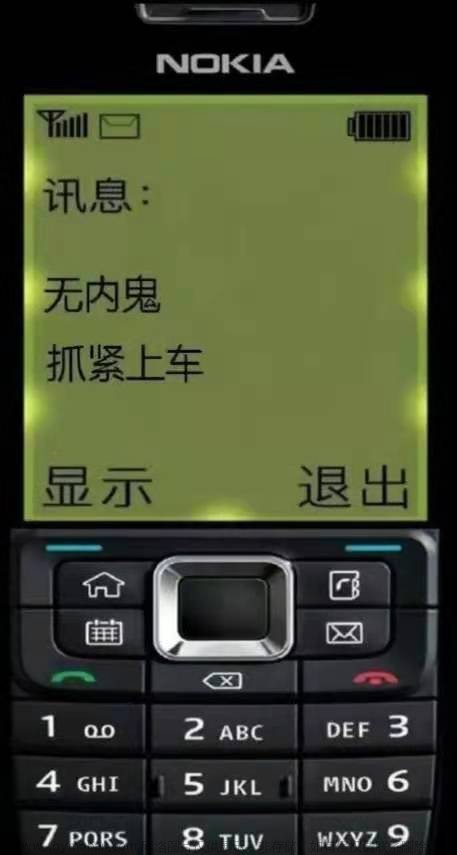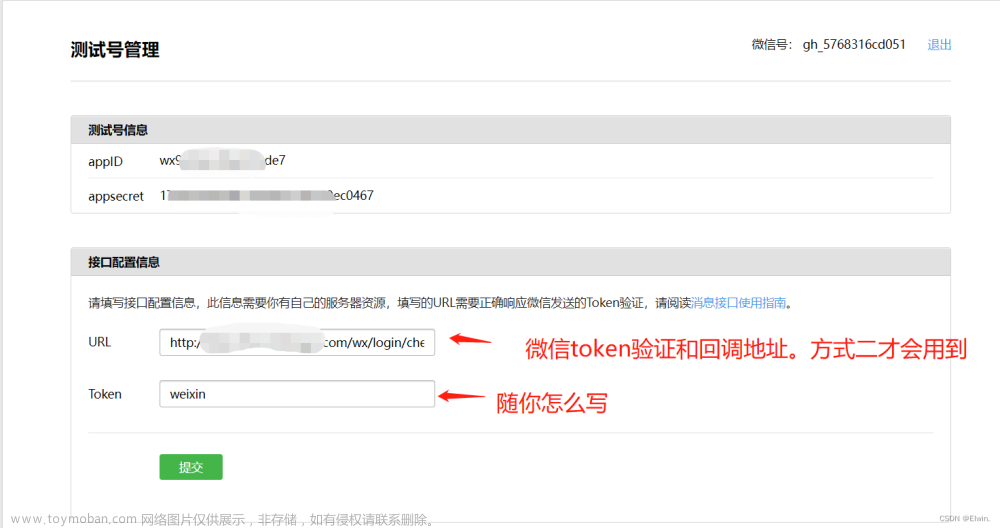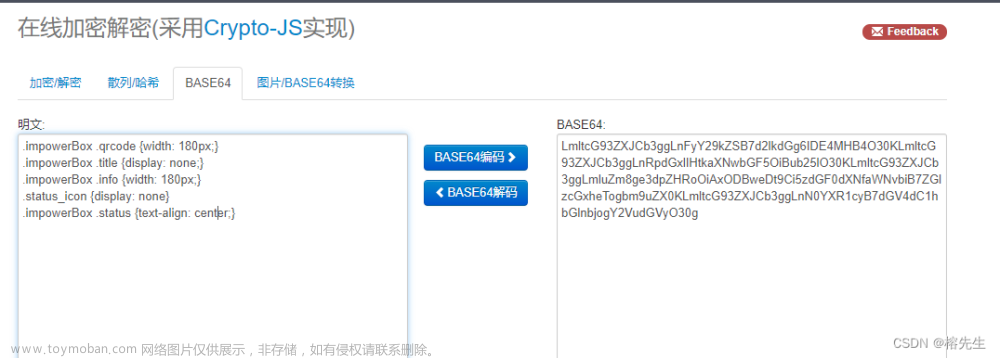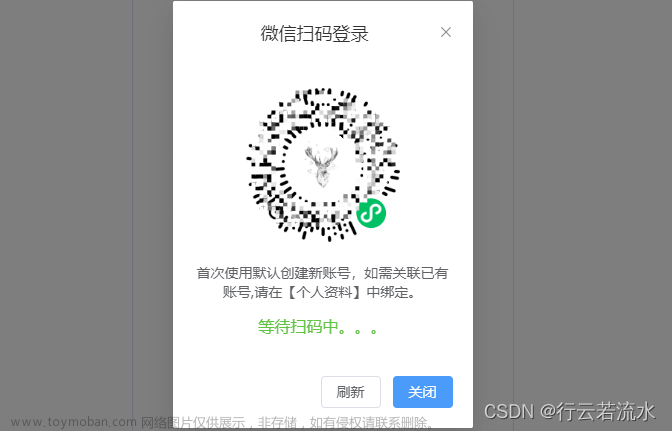文件目录结构
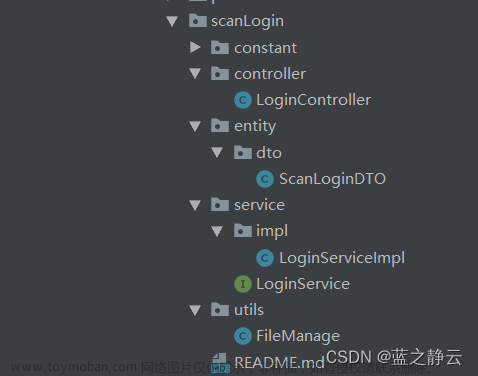
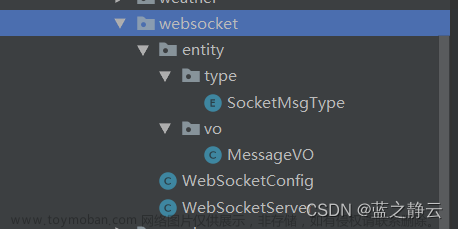 文章来源地址https://www.toymoban.com/news/detail-724538.html
文章来源地址https://www.toymoban.com/news/detail-724538.html
web(vue)
destroyWs(){
// 断开ws
if(window.ws) {
window.ws.onclose = null;
window.ws.onerror = null;
window.ws.close();
window.ws = null;
}
},
connSocket() {
const _t = this;
try{
window.ws = new WebSocket(`${socketUrl}${shortUrl}${wsShortUrl}/${_t.loginScanParams.scene}/${_t.loginScanParams.oldScene || '-'}`);
//申请一个WebSocket对象,参数是服务端地址,同http协议使用http://开头一样,WebSocket协议的url使用ws://开头,另外安全的WebSocket协议使用wss://开头
window.ws.onopen = function () {
console.log("即时通讯已启动");
}
window.ws.onmessage = function (Message) {
// 判断消息类型作出相应操作
let data = {};
try {
data = JSON.parse(Message.data);
} catch (e) {
console.error(e);
}
console.log("收到消息", data)
// 更新扫码状态
if(data.type === 5){
if(data.data) _t.scanResultAction(data.data);
}
}
window.ws.onclose = function (e) {
//当客户端收到服务端发送的关闭连接请求时,触发onclose事件
console.log("连接断开", e);
// 断线重连尝试6次
if(wsConnCount > 4) return;
if(window.wsTimer) clearTimeout(window.wsTimer)
window.wsTimer = setTimeout(() => {
// 断线重连计数
wsConnCount ++;
// 断线重连
_t.connSocket();
}, 3000)
}
window.ws.onerror = function (e) {
//如果出现连接、处理、接收、发送数据失败的时候触发onerror事件
console.log("网络错误,连接断开", e);
// 断线重连尝试6次
if(wsConnCount > 4) return;
if(window.wsTimer) clearTimeout(window.wsTimer)
window.wsTimer = setTimeout(() => {
// 断线重连计数
wsConnCount ++;
_t.connSocket();
}, 3000)
}
}catch(e){
console.log(e);
}
},
async scanLogin() {
const _t = this;
_t.loginScanParams.scanStatus = "wait";
_t.loginScanParams.loading = true
// 获取二维码
const res = await createLogin({
scene: _t.loginScanParams.scene
});
console.log("创建二维码返回结果:", res)
// 存储旧的场景值
_t.loginScanParams.oldScene = _t.loginScanParams.scene;
const scene = _t.loginScanParams.scene = res
// 拼接 小程序码url
_t.loginScanParams.qrcodeUrl = `${baseUrl}${shortUrl}/login/qrcode/${scene}.jpg`
_t.loginScanParams.loading = false
_t.connSocket();
},
scanResultAction(res){
const _t = this;
const { avatar, status, openId } = res;
if (status === 'ing') {
// 用户进入小程序(已扫码)
_t.loginScanParams.scanStatus = 'ing'
// 显示已扫码
_t.loginScanParams.scanning = 'true'
// 显示用户头像
if(avatar) _t.loginScanParams.qrcodeUrl = `data:image/png;base64, ${avatar}`
else _t.loginScanParams.qrcodeUrl = require('./logo.png')
} else if (status === 'success') {
_t.loginScanParams.scanStatus = "success"
// 执行常规登录
_t.$store.dispatch("scanLogin", {
userType: "0",
loginType: "web",
openid: sm2Encrypt(openId)
}).then(res => {
console.log("扫码登录情况:", res)
const { success, code, result } = res;
if(success) {
if(result.data.menus.length === 0) {
_t.loginScanParams.scanStatus = "noAuth"
_t.loginScanParams.qrcodeUrl = require("./sad.png")
}else {
// 断开ws
_t.destroyWs()
// 拿到必要信息执行登录
}
}else {
if(code === 502) {
_t.loginScanParams.scanStatus = "noRegister"
_t.loginScanParams.qrcodeUrl = require("./sad.png")
}
}
})
} else if (status === "cancel") { // 用户点击取消认证,处理业务结束轮询
_t.loginScanParams.scanStatus = status
}
},
uni-app
<template>
<view class="auth" :style="{ paddingTop: navigationBarHeight +'px' }">
<view class="top">
<view style="padding-right: 10px; display: inline-block;" @click="exit">
<text class="iconfont icon-delete" style="color: #212121;font-size: 19px;"></text>
</view>
</view>
<view class="center">
<view style="height: 60%; flex-direction: column;" class="flex-center">
<view v-if="showAvatar" class="flex-center" style="width: 300rpx; height: 300rpx;">
<image v-if="authInfo.avatar" :src="avatarCpd" mode="widthFix" style="width: 100%; border-radius: 10px; box-shadow: 4px 2px 6px #ccc;"></image>
<loading v-else></loading>
</view>
<text v-else class="iconfont icon-PC" style="font-weight: 100; font-size: 150px; color: #8d8d8d;"></text>
<text style="margin-top: 10px; color: #333333; font-size: 38rpx; font-weight: 500" v-if="status !== 'success'">登录 PC 正域绿能</text>
<text style="margin-top: 10px; color: #333333; font-size: 38rpx; font-weight: 500" v-else>已成功认证</text>
</view>
<view style="height: 40%; flex-direction: column;" class="flex-center">
<navigator open-type="exit" target="miniProgram" v-if="status === 'success'">
<button
type="default"
style="padding: 0 150rpx; color: #24b155">我知道了</button>
</navigator>
<template v-else>
<button type="primary" :loading="loading" @tap="handleUserAuth"
style="background-color: #27c05e; padding: 0 150rpx">登录</button>
<text @tap="exit" style="margin-top: 25px; color: #62708e; font-size: 17px">取消登录</text>
<template v-if="!isRelease">
<uni-easyinput v-model="scene" :inputBorder="true" style="margin-top: 10px" placeholder="场景值"
clearable />
<text @tap="load" style="margin-top: 25px; color: #62708e; font-size: 17px">模拟进入</text>
</template>
</template>
</view>
</view>
</view>
</template>
<script>
import {
mapGetters
} from 'vuex'
import {
handleUserScan,
handleUserCancel,
handleUserAuth
} from '@/common/api/user'
import { isRelease } from '@/common/env'
export default {
data() {
return {
showAvatar: true,
isRelease: isRelease,
loading: false,
// 用户信息
authInfo: {},
// 用户唯一标识
openid: '',
// 场景值
scene: '',
// 扫描状态,用于退出登录界面
status: 'wait'
};
},
computed: {
...mapGetters(['systemInfo']),
avatarCpd(){
return `data:image/png;base64,${this.authInfo.avatar}`.replace(/[\r\n]/g, "");
},
navigationBarHeight(){
return this.systemInfo.navigationBarHeight
}
},
async onLoad(options) {
const _t = this;
if(!options.scene && _t.isRelease) return _t.$mRouter.redirectTo("/pages/transfer/transfer")
_t.showAvatar = true;
// 对scene进行解码
const scene = decodeURIComponent(options.scene) || ""
// const scene = _t.scene
console.log('scene >>>', scene)
_t.scene = scene
const code = await _t.getCode();
// 1、修改 认证状态为 已扫码
const res = await handleUserScan({
scene: scene,
code: code
})
console.log("修改状态情况", res)
const {
code: resCode,
data
} = res.data;
if (resCode === 200) _t.authInfo = data;
if(!_t.authInfo.avatar) _t.showAvatar = false
},
methods: {
async load() {
const _t = this;
// 对scene进行解码
// const scene = decodeURIComponent(options.scene)
const scene = _t.scene
console.log('scene >>>', scene)
_t.scene = scene
const code = await _t.getCode();
// 1、修改 认证状态为 已扫码
const res = await handleUserScan({
scene: scene,
code: code
})
console.log("修改状态情况", res)
const {
code: resCode,
data
} = res.data;
if (resCode === 200) _t.authInfo = data;
if(!_t.authInfo.avatar) _t.showAvatar = false
},
// 获取微信code
async getCode() {
const code = await this.login();
return code ? code : '';
},
// 微信登录
login() {
return new Promise(resolve => {
uni.login({
provider: 'weixin',
success(loginRes) {
console.log("获取code成功")
resolve(loginRes.code)
},
fail(err) {
resolve('');
}
});
})
},
// 点击认证时绑定的事件,获取用户信息
async handleUserAuth() {
const _t = this;
_t.loading = true;
const code = await _t.getCode();
console.log("权限信息:", _t.authInfo);
const res = await handleUserAuth({
nickname: _t.authInfo.username || "",
openId: _t.authInfo.wechatOpenid || "",
avatar: _t.authInfo.avatar || "",
scene: _t.scene || ""
})
console.log("认证情况", res);
const {
success,
code: resCode,
message
} = res.data
if (resCode === 200) {
_t.status = 'success'
_t.$cu.showToast("认证成功");
}
_t.loading = false;
},
// 用户点击 取消认证,或已认证,返回微信
async exit() {
const _t = this;
// 如果状态为 wait 说明用户 未认证点击了取消登录
if (_t.status === 'wait') {
// 发送请求,将数据库状态修改为 cancel,再执行退出
const res = await handleUserCancel({
scene: _t.scene
});
console.log("取消认证情况", res);
if (res.data.code === 200) {
console.log("退出小程序");
// 执行退出小程序
wx.exitMiniProgram({
success: res => {
console.log(res)
}
})
}
} else {
//否则,说明已认证,直接退出小程序即可
console.log("退出小程序");
wx.exitMiniProgram({
success: res => {
console.log(res)
}
})
}
}
}
}
</script>
<style lang="scss">
.auth {
width: 100%;
height: 100vh;
background-color: #ededed;
box-sizing: border-box;
position: relative;
padding: 0 20rpx;
.top {
width: 100%;
}
.center {
width: 100%;
height: 75vh;
margin-top: 5vh;
border-radius: 10px;
background-color: #fff;
}
}
</style>
SocketMsgType
import lombok.Getter;
import java.util.HashMap;
import java.util.Map;
/**
* @company BN
* @description 用户类型枚举
* @author WuTongYue
* @date 2022-01-06
**/
public enum SocketMsgType {
CONN_SUCCESS(1, "连接成功"),
CONN_FAIL(2, "连接失败"),
SHUT_LINE(3, "被踢下线"),
USER_ONLINE(4, "用户在线情况"),
SCAN_STATUS(5, "扫码状态");
@Getter
private final Integer code;
@Getter
private final String name;
SocketMsgType(Integer code, String name) {
this.code = code;
this.name = name;
}
private static Map<Integer, SocketMsgType> KEY_MAP_CODE = new HashMap<>();
private static Map<String, SocketMsgType> KEY_MAP_NAME = new HashMap<>();
static {
for (SocketMsgType value : values()) {
KEY_MAP_CODE.put(value.getCode(), value);
KEY_MAP_NAME.put(value.getName(), value);
}
}
public static SocketMsgType getCode(Integer code) {
return KEY_MAP_CODE.get(code);
}
public static SocketMsgType getName(String name) {
return KEY_MAP_NAME.get(name);
}
}
MessageVO
import lombok.Data;
import java.io.Serializable;
@Data
public class MessageVO<T> implements Serializable {
/**
* 消息类型
*/
private Integer type;
/**
* 消息
*/
private String message;
/**
* 数据
*/
private T data;
}
WebSocketConfig
import org.springframework.context.annotation.Bean;
import org.springframework.context.annotation.Configuration;
import org.springframework.web.socket.server.standard.ServerEndpointExporter;
/**
* 开启ws支持
* @author wutongyue
*/
@Configuration
public class WebSocketConfig {
@Bean
public ServerEndpointExporter serverEndpointExporter() {
return new ServerEndpointExporter();
}
}
WebSocketServer
import com.alibaba.fastjson.JSON;
import com.alibaba.fastjson.JSONObject;
import com.bn.ies.appapi.scanLogin.service.LoginService;
import com.bn.ies.base.websocket.entity.type.SocketMsgType;
import com.bn.ies.base.websocket.entity.vo.MessageVO;
import org.apache.commons.lang.StringUtils;
import org.apache.logging.log4j.LogManager;
import org.apache.logging.log4j.Logger;
import org.springframework.beans.factory.annotation.Autowired;
import org.springframework.stereotype.Component;
import javax.websocket.*;
import javax.websocket.server.PathParam;
import javax.websocket.server.ServerEndpoint;
import java.io.IOException;
import java.util.concurrent.ConcurrentHashMap;
/**
* ws
* @Author WuTongYue
* @Date 2023/06/05
*/
@ServerEndpoint("/ws/{userId}/{oldUserId}")
@Component
public class WebSocketServer {
// 日志
private static Logger log = LogManager.getLogger(WebSocketServer.class);
/**静态变量,用来记录当前在线连接数。应该把它设计成线程安全的。*/
private static int onlineCount = 0;
/**concurrent包的线程安全Set,用来存放每个客户端对应的MyWebSocket对象。*/
private static ConcurrentHashMap<String,WebSocketServer> webSocketMap = new ConcurrentHashMap<>();
/**与某个客户端的连接会话,需要通过它来给客户端发送数据*/
private Session session;
/**接收userId*/
private String userId = "";
/**查询用户在线情况服务类*/
private static LoginService loginService;
@Autowired
public void setSysUserOnlineService(LoginService loginService){
WebSocketServer.loginService = loginService;
}
/**
* 连接建立成功调用的方法*/
@OnOpen
public void onOpen(Session session, @PathParam("userId") String userId, @PathParam("oldUserId") String oldUserId) {
System.out.println("用户"+userId+"连接建立");
this.session = session;
this.userId = userId;
// 清除单个旧的连接(多人同时扫码可能存在相同scene,可用雪花算法保证唯一,或者场景值增加客户端ip)
if(webSocketMap.containsKey(oldUserId)){
webSocketMap.remove(oldUserId);
subOnlineCount();
}
if(webSocketMap.containsKey(userId)){
webSocketMap.remove(userId);
webSocketMap.put(userId,this);
}else{
webSocketMap.put(userId,this);
//在线数加1
addOnlineCount();
}
log.info("用户连接:"+userId+",当前在线人数为:" + getOnlineCount());
try {
MessageVO<String> messageVO = new MessageVO<>();
messageVO.setMessage("连接成功~");
messageVO.setData(SocketMsgType.CONN_SUCCESS.getName());
messageVO.setType(SocketMsgType.CONN_SUCCESS.getCode());
sendMessage(JSON.toJSONString(messageVO));
} catch (IOException e) {
log.error("用户:"+userId+",网络异常!");
}
}
/**
* 连接关闭调用的方法
*/
@OnClose
public void onClose() {
if(webSocketMap.containsKey(userId)){
webSocketMap.remove(userId);
// 从set中删除
subOnlineCount();
// 业务删除
loginService.delete(userId);
}
log.info("用户退出:"+userId+",当前在线人数为:" + getOnlineCount());
}
/**
* 收到客户端消息后调用的方法
*
* @param message 客户端发送过来的消息*/
@OnMessage
public void onMessage(String message, Session session) {
log.info("用户消息:"+userId+",报文:"+message);
//可以群发消息
//消息保存到数据库、redis
if(StringUtils.isNotBlank(message)){
try {
webSocketMap.get(userId).sendMessage("lys");
//解析发送的报文
JSONObject jsonObject = JSON.parseObject(message);
//追加发送人(防止串改)
jsonObject.put("fromUserId",this.userId);
String toUserId=jsonObject.getString("toUserId");
//传送给对应toUserId用户的websocket
if(StringUtils.isNotBlank(toUserId)&&webSocketMap.containsKey(toUserId)){
webSocketMap.get(toUserId).sendMessage(JSON.toJSONString(jsonObject));
}else{
log.error("请求的userId:"+toUserId+"不在该服务器上");
//否则不在这个服务器上,发送到mysql或者redis
}
}catch (Exception e){
e.printStackTrace();
}
}
}
/**
*
* @param session
* @param error
*/
@OnError
public void onError(Session session, Throwable error) {
log.error("用户错误:" + userId + ",原因:" +error.getMessage());
error.printStackTrace();
// 业务删除
loginService.delete(userId);
}
/**
* 实现服务器主动推送
*/
public void sendMessage(String message) throws IOException {
this.session.getBasicRemote().sendText(message);
}
/**
* 发送自定义消息
* */
public static void sendInfo(String message,@PathParam("userId") String userId) throws IOException {
if(StringUtils.isNotBlank(userId)&&webSocketMap.containsKey(userId)){
webSocketMap.get(userId).sendMessage(message);
}else{
log.error("用户"+userId+",不在线!");
}
}
public static synchronized int getOnlineCount() {
return onlineCount;
}
public static synchronized void addOnlineCount() {
WebSocketServer.onlineCount++;
}
public static synchronized void subOnlineCount() {
WebSocketServer.onlineCount--;
}
}
ScanStatus
import lombok.AllArgsConstructor;
import lombok.Getter;
/**
* 登录扫码状态
*
* @author 蓝之静云
*/
@AllArgsConstructor
@Getter
public enum ScanStatus {
/**
* 等待扫码
*/
WAIT("wait"),
/**
* 已扫码
*/
ING("ing"),
/**
* 认证成功
*/
SUCCESS("success"),
/**
* 取消认证
*/
CANCEL("cancel");
/**
* 扫码状态
*/
private String status;
}
LoginController
import com.alibaba.fastjson.JSON;
import com.alibaba.fastjson.JSONObject;
import com.bn.ies.appapi.scanLogin.constant.ScanStatus;
import com.bn.ies.appapi.scanLogin.entity.dto.ScanLoginDTO;
import com.bn.ies.appapi.scanLogin.service.LoginService;
import com.bn.ies.appapi.system.utils.WeixinUtils;
import com.bn.ies.base.config.FileProperties;
import com.bn.ies.base.entity.Result;
import com.bn.ies.base.entity.po.SysUser;
import com.bn.ies.base.websocket.WebSocketServer;
import com.bn.ies.base.websocket.entity.type.SocketMsgType;
import com.bn.ies.base.websocket.entity.vo.MessageVO;
import io.swagger.annotations.ApiOperation;
import org.springframework.beans.factory.annotation.Autowired;
import org.springframework.web.bind.annotation.*;
import javax.servlet.ServletOutputStream;
import javax.servlet.http.HttpServletRequest;
import javax.servlet.http.HttpServletResponse;
import java.io.File;
import java.io.FileInputStream;
import java.io.IOException;
/**
* @author 蓝之静云
*/
@RestController
@RequestMapping("/login")
public class LoginController {
@Autowired
private LoginService loginService;
@Autowired
private FileProperties properties;
/**
* 创建 scanLoginDTO 数据
*
* @return 文件名
*/
@PostMapping("create")
public String createUserLogin(@RequestBody ScanLoginDTO scanLoginDTO){
return loginService.createAndGetQrcodeFile(scanLoginDTO.getScene());
}
@GetMapping("/qrcode/{name:.+}")
@ApiOperation("根据名称获取图片资源")
public void getImg(@PathVariable("name") String name, HttpServletResponse response) throws Exception {
ServletOutputStream outputStream = null;
FileInputStream inputStream = null;
try {
String imgPath = properties.getPath().getQrCode() + File.separator + name;
inputStream = new FileInputStream(imgPath);
response.setContentType("image/" + name.split("\\.")[1]);
outputStream = response.getOutputStream();
int len;
byte[] buffer = new byte[4096];
while ((len = inputStream.read(buffer)) != -1) {
outputStream.write(buffer, 0, len);
}
outputStream.flush();
} catch (Exception e) {
e.printStackTrace();
} finally {
outputStream.close();
inputStream.close();
}
}
/**
* 修改扫码状态为 已扫码
*
* @param scanLoginDTO 登录信息
*/
@PostMapping("scan")
public Result<?> userScanQrcode(ScanLoginDTO scanLoginDTO, HttpServletRequest request) throws Exception{
JSONObject json = WeixinUtils.getSession(scanLoginDTO.getCode());
if (json == null) return Result.fail("获取openid失败");
String openId = json.getString("openid");
// 通过openid查询用户信息返回
SysUser userInfo = loginService.getUserInfoByOpenid(openId, request);
userInfo.setWechatOpenid(openId);
scanLoginDTO.setAvatar(userInfo.getAvatar());
scanLoginDTO.setOpenId(openId);
scanLoginDTO.setStatus(ScanStatus.ING.getStatus());
MessageVO<ScanLoginDTO> messageVO = new MessageVO<>();
messageVO.setData(scanLoginDTO);
messageVO.setType(SocketMsgType.SCAN_STATUS.getCode());
WebSocketServer.sendInfo(JSON.toJSONString(messageVO), scanLoginDTO.getScene());
return Result.success(userInfo);
}
/**
* 用户点击确认
*
* @param scanLoginDTO 登录信息
*/
@PostMapping("auth")
public Result<?> userAuthWebPro(ScanLoginDTO scanLoginDTO) throws IOException {
scanLoginDTO.setStatus(ScanStatus.SUCCESS.getStatus());
MessageVO<ScanLoginDTO> messageVO = new MessageVO<>();
messageVO.setData(scanLoginDTO);
messageVO.setType(SocketMsgType.SCAN_STATUS.getCode());
String scene = scanLoginDTO.getScene();
WebSocketServer.sendInfo(JSON.toJSONString(messageVO), scene);
loginService.delete(scene);
return Result.success("认证成功");
}
/**
* 用户取消认证
*
* @param params
*/
@PostMapping("cancel")
public Result<?> userCancelAuth(@RequestBody JSONObject params) throws IOException {
ScanLoginDTO scanLoginDTO = new ScanLoginDTO();
String scene = params.getString("scene");
scanLoginDTO.setScene(scene);
scanLoginDTO.setStatus(ScanStatus.CANCEL.getStatus());
MessageVO<ScanLoginDTO> messageVO = new MessageVO<>();
messageVO.setData(scanLoginDTO);
messageVO.setType(SocketMsgType.SCAN_STATUS.getCode());
WebSocketServer.sendInfo(JSON.toJSONString(messageVO), scene);
loginService.delete(scene);
return Result.success("取消认证成功");
}
}
ScanLoginDTO
import lombok.Data;
/**
* @author 蓝之静云
*/
@Data
public class ScanLoginDTO {
private String id;
/**
* 场景值
*/
private String scene;
/**
* 状态
*/
private String status;
/**
* 用户ID
*/
private String userId;
/**
* code码
*/
private String code;
/**
* 开放ID
*/
private String openId;
/**
* 用户头像
*/
private String avatar;
}
LoginServiceImpl
import com.alibaba.fastjson.JSON;
import com.alibaba.fastjson.JSONObject;
import com.bn.df.common.api.vo.Result;
import com.bn.ies.appapi.scanLogin.service.LoginService;
import com.bn.ies.appapi.scanLogin.utils.FileManage;
import com.bn.ies.base.config.FileProperties;
import com.bn.ies.base.entity.po.SysUser;
import com.bn.ies.util.HeaderUtil;
import com.bn.ies.util.IscPropertiesUtils;
import com.bn.ies.util.UserUtil;
import org.apache.http.HttpEntity;
import org.apache.http.HttpResponse;
import org.apache.http.client.methods.HttpPost;
import org.apache.http.entity.StringEntity;
import org.apache.http.impl.client.DefaultHttpClient;
import org.apache.http.message.BasicHeader;
import org.apache.http.protocol.HTTP;
import org.springframework.beans.factory.annotation.Autowired;
import org.springframework.beans.factory.annotation.Value;
import org.springframework.http.HttpHeaders;
import org.springframework.http.HttpMethod;
import org.springframework.http.ResponseEntity;
import org.springframework.stereotype.Service;
import org.springframework.web.client.RestTemplate;
import javax.servlet.http.HttpServletRequest;
import java.io.*;
import java.util.HashMap;
import java.util.Map;
import java.util.UUID;
/**
* @author 蓝之静云
*/
@Service
public class LoginServiceImpl implements LoginService {
@Value("${wxmini.appid}")
private String appid;
@Value("${wxmini.secret}")
private String secret;
@Autowired
private FileProperties properties;
@Autowired
private RestTemplate restTemplate;
@Override
public String createAndGetQrcodeFile(String s) {
// 1、创建文件名及scene值
String scene = UUID.randomUUID().toString().replaceAll("-", "");
// 2、获取token
String accessToken = getAccessToken();
// 3、请求图片流
InputStream inputStream = getwxacode(accessToken, scene);
// 删除原有图标文件(若存在)
FileManage.delFileByPath(properties.getPath().getQrCode() + File.separator + s + ".jpg");
// 4、保存图标文件
saveToImgByInputStream(inputStream,scene);
// 5、删除冗余数据
this.delete(s);
return scene;
}
@Override
public SysUser getUserInfoByOpenid(String openid, HttpServletRequest request) {
SysUser sysUser = new SysUser();
try {
//设置请求头携带token
HttpHeaders headers = HeaderUtil.getHttpHeaders(UserUtil.getToken(request));
JSONObject json = new JSONObject();
json.put("openid", openid);
org.springframework.http.HttpEntity<JSONObject> params = new org.springframework.http.HttpEntity<>(json, headers);
//请求获取用户列表
ResponseEntity<Result> usernameListResponse = restTemplate.exchange(IscPropertiesUtils.getUserInfoByOpenidUrl(), HttpMethod.POST, params, Result.class);
Map<String, Object> userInfo = (HashMap)usernameListResponse.getBody().getResult();
sysUser.setAvatar((String)userInfo.getOrDefault("avatar", ""));
sysUser.setUsername((String)userInfo.getOrDefault("username", ""));
} catch (Exception e) {
return sysUser;
}
return sysUser;
}
@Override
public void delete(String scene) {
// 删除图片文件
FileManage.delFileByPath(properties.getPath().getQrCode() + File.separator + scene + ".jpg");
}
/**
* 获取access_token
* @return access_token
*/
private String getAccessToken(){
RestTemplate restTemplate = new RestTemplate();
Map<String, String> params = new HashMap<>();
params.put("APPID", appid);
params.put("APPSECRET", secret);
ResponseEntity<String> responseEntity = restTemplate.getForEntity(
"https://api.weixin.qq.com/cgi-bin/token?grant_type=client_credential&appid={APPID}&secret={APPSECRET}",
String.class, params);
String body = responseEntity.getBody();
JSONObject object = JSON.parseObject(body);
return object.getString("access_token");
}
/**
1. 带参数有限个数小程序码接口
2. @param url
3. @param access_token
4. @param path
5. @param width
6. @return
*/
private static InputStream getwxacode(String accessToken, String scene){
String url = "https://api.weixin.qq.com/wxa/getwxacodeunlimit?access_token=" + accessToken;
JSONObject jsonParam = new JSONObject();
// 封装请求对象
// scene值
jsonParam.put("scene", scene);
// 跳往的小程序页面,一般为认证界面
jsonParam.put("page","pages/oauth/oauth");
// 图片宽度,默认为 430
jsonParam.put("width","430");
// 检测页面是否存在,默认为 true
jsonParam.put("check_path",true);
// 返回请求结果
return doWxPost(url, jsonParam);
}
/**
* IO流保存图片
*
* @param instreams 需要保存的流
* @param imagePath 保存的图片路径
* @param fileName 文件名
* @return 保存状态
*/
private static boolean uploadImages( InputStream instreams,String imagePath,String fileName) {
File f = new File(imagePath);
f.setWritable(true, false);
boolean flag = false;
try {
// 1K的数据缓冲
byte[] bs = new byte[1024];
// 读取到的数据长度
int len;
// 输出的文件流
File file = new File(imagePath,fileName);
if (!file.getParentFile().exists()) {
file.getParentFile().mkdirs();
try {
// 创建新文件
file.createNewFile();
} catch (IOException e) {
System.out.println("创建新文件时出现了错误。。。");
e.printStackTrace();
}
}
OutputStream os = new FileOutputStream(imagePath+File.separator+fileName);
// 开始读取
while ((len = instreams.read(bs)) != -1) {
os.write(bs, 0, len);
}
// 完毕,关闭所有链接
os.close();
instreams.close();
flag = true;
} catch (IOException e) {
e.printStackTrace();
}
return flag;
}
/**
* 通过流保存图片
*
* @param instreams 二进制流
* @param fileName 图片的名称
*/
private void saveToImgByInputStream(InputStream instreams, String fileName) {
if (instreams != null) {
boolean b = uploadImages(instreams, properties.getPath().getQrCode(), fileName + ".jpg");
}
}
/**
* 发送post请求
*
* @param url 请求地址
* @param jsonParam 请求参数
* @return 响应流
*/
private static InputStream doWxPost(String url, JSONObject jsonParam) {
InputStream instreams = null;
// 创建HttpPost对象
HttpPost httpRequst = new HttpPost(url);
try {
StringEntity se = new StringEntity(jsonParam.toString(),"utf-8");
se.setContentType("application/json");
se.setContentEncoding(new BasicHeader(HTTP.CONTENT_TYPE,"UTF-8"));
httpRequst.setEntity(se);
HttpResponse httpResponse = new DefaultHttpClient().execute(httpRequst);
if (httpResponse.getStatusLine().getStatusCode() == 200) {
HttpEntity httpEntity = httpResponse.getEntity();
if (httpEntity != null) {
instreams = httpEntity.getContent();
}
}
} catch (IOException e) {
e.printStackTrace();
}
return instreams;
}
}
LoginService
import com.bn.ies.base.entity.po.SysUser;
import javax.servlet.http.HttpServletRequest;
/**
* @author 蓝之静云
*/
public interface LoginService {
/**
* 请求创建图片文件并返回文件名
*
* @return 返回scene值,作为网站做剩余操作的依据
*/
String createAndGetQrcodeFile(String scene);
/**
* 通过openid获取用户信息
* @return
*/
SysUser getUserInfoByOpenid(String openid, HttpServletRequest request);
/**
* 根据场景值执行删除冗余数据
* @param scene
*/
void delete(String scene);
}
FileManage
import org.springframework.web.multipart.MultipartFile;
import java.io.File;
import java.io.IOException;
import java.util.UUID;
/**
* 文件管理工具
*
* @author 蓝之静云
*/
public class FileManage {
/**
* 根据路径和文件名删除图片
*
* @param path 路径和文件名
* @return 1表示删除成功
* 0表示删除失败
* -1表示文件不存在
*/
public static int delFileByPath(String path){
int resultInfo;
File file = new File(path);
//文件是否存在
if (file.exists()) {
//存在就删了,返回1
if (file.delete()) {
resultInfo = 1;
} else {
resultInfo = 0;
}
} else {
resultInfo = -1;
}
return resultInfo;
}
/**
* 上传保存图片
*
* @param file 文件
* @param uploadPath 上传路径
* @return 文件名
* @throws IOException
*/
public static String saveUploadFile(MultipartFile file, String uploadPath) throws IOException {
// 获取文件名
String fileName = file.getOriginalFilename();
String subfix = fileName.substring(fileName.lastIndexOf("."));
String uploadFileName = UUID.randomUUID().toString() + subfix;
System.out.println("上传文件名 : " + uploadFileName);
//如果路径不存在,创建一个
File realPath = new File(uploadPath);
if (!realPath.exists()) {
realPath.mkdir();
}
System.out.println("上传文件保存地址:"+realPath);
file.transferTo(new File(uploadPath+"/"+uploadFileName));
return uploadFileName;
}
}
操作流程
#### 操作流程
此项目结合webSocket实现扫码登录
**微信扫码登录时序**
1、获取小程序码时,建立ws,并返回scene值。
2、之后后端根据用户客户端操作情况推动认证状态至网页端。
3、扫码进入后更新扫码状态为 正在扫码
4、用户点击认证或者取消认证,更改扫码状态为对应的内容。
5、如果是已认证,通过openId执行常规登录
6、为了避免垃圾信息。在已认证或取消认证后清除相关信息
yml
# 文件存储路径
file:
mac:
#扫码登录生成的二维码存放路径
qrCode: ~/wxImgs/qrCode/
linux:
qrCode: /home/wxImgs/qrCode/
windows:
qrCode: D:\wxImgs\qrCode\
# 文件大小 /M
maxSize: 10
FileProperties
/*
* Copyright 2019-2020 WuTongyue
*
* Licensed under the Apache License, Version 2.0 (the "License");
* you may not use this file except in compliance with the License.
* You may obtain a copy of the License at
*
* http://www.apache.org/licenses/LICENSE-2.0
*
* Unless required by applicable law or agreed to in writing, software
* distributed under the License is distributed on an "AS IS" BASIS,
* WITHOUT WARRANTIES OR CONDITIONS OF ANY KIND, either express or implied.
* See the License for the specific language governing permissions and
* limitations under the License.
*/
package com.bn.ies.base.config;
import com.bn.ies.base.constant.PhysicsConstant;
import lombok.Data;
import org.springframework.boot.context.properties.ConfigurationProperties;
import org.springframework.context.annotation.Configuration;
/**
* @author WuTongyue
* @date 2023/03/17
*/
@Data
@Configuration
@ConfigurationProperties(prefix = "file")
public class FileProperties {
/** 文件大小限制 */
private Long maxSize;
private ElPath mac;
private ElPath linux;
private ElPath windows;
public ElPath getPath(){
String os = System.getProperty("os.name");
if(os.toLowerCase().startsWith(PhysicsConstant.WIN)) {
return windows;
} else if(os.toLowerCase().startsWith(PhysicsConstant.MAC)){
return mac;
}
return linux;
}
@Data
public static class ElPath{
private String qrCode;
}
}
文章来源:https://www.toymoban.com/news/detail-724538.html
到了这里,关于即时通讯实现微信扫码登录web网站(vue + uni-app + java + 微信小程序)的文章就介绍完了。如果您还想了解更多内容,请在右上角搜索TOY模板网以前的文章或继续浏览下面的相关文章,希望大家以后多多支持TOY模板网!


